constituent assembly of india debates (proceedings)- volume vii
constituent assembly of india debates (proceedings)- volume vii
constituent assembly of india debates (proceedings)- volume vii
Create successful ePaper yourself
Turn your PDF publications into a flip-book with our unique Google optimized e-Paper software.
punctuated by disorder and even rebellion until special and adequate protection was given. In the fringe<br />
areas, such as Manbhum, where the non-aboriginals are in a majority, the aboriginal element would<br />
probably have been driven from the land long ago but for the protection given by tenancy laws.<br />
........The fate <strong>of</strong> the aboriginal where he has been unprotected has usually been to lose his land........"<br />
In the Santhal Parganas, legislation since 1855 has been mainly by means <strong>of</strong> special regulations framed<br />
by the Governor-General-in-Council. The main function <strong>of</strong> these regulations was to regulate inter alia the<br />
agrarian law, the constitution <strong>of</strong> courts and their procedure, money lending and the village police. Except<br />
in the most important cases the jurisdiction <strong>of</strong> the High Court was excluded and judicial procedure<br />
simplified. In the Kolhanpir <strong>of</strong> the Singhhum District also, the Civil Procedure Code was replaced by<br />
simplified rules but generally speaking, the laws <strong>of</strong> the rest <strong>of</strong> the province operate in Chota Nagpur. For<br />
a detailed account, the Factual Memorandum <strong>of</strong> the Provincial Government may be referred to (pages<br />
97-98,Excluded and Partially Excluded Areas - I). Since 1937, section 92 (2) <strong>of</strong> the Government <strong>of</strong> India<br />
Act has been made use <strong>of</strong> to frame some special regulations notably for the Santhal Parganas.<br />
The population <strong>of</strong> Chota Nagpur and the Santhal Pargnas is rather mixed and except in the Ranchi<br />
District, the Singhbhum District and the Santhal Parganas, the tribal population are in a minority. In their<br />
Factual Memorandum, the Bihar Government have pointed out that a comparison between the figures <strong>of</strong><br />
1941 and 1931 census shows that there is room for doubting the accuracy <strong>of</strong> the figures <strong>of</strong> the 1941<br />
census. Recently an agitation has been started for the formation <strong>of</strong> a separate Chota Nagpur Province on<br />
the ground that this land is the land <strong>of</strong> the aboriginal residents who are distinct from the inhabitants <strong>of</strong><br />
the plains in many ways. Taken as a whole, the tribals form only 45.6 per cent <strong>of</strong> the total population <strong>of</strong><br />
the Partially Excluded Areas and in Chota Nagpur they constitute 44.2 per cent <strong>of</strong> the population. Only in<br />
Ranchi (70 per cent), Singhbhum (58.4 per cent) and Santhal Parganas (50.6 per cent) are they in<br />
anything like a majority. The creation <strong>of</strong> a separate province is a matter outside the scope <strong>of</strong> our enquiry<br />
and we do not find that this is in fact necessary for the satisfactory administration <strong>of</strong> the tribals.<br />
-------------------------------------------------<br />
* Now in Orissa<br />
* Reference to pages is to pages in the original report<br />
-------------------------------------------------<br />
(g) United Provinces. - The partially excluded areas are the Pargana inhabited by the Jaunsari<br />
tribes in the north and the portion <strong>of</strong> the Mirzapur District below the Kaimur Range inhabited by mixed<br />
tribes <strong>of</strong> Chota Nagpur and Central India. The area is 483 sq. miles in the Dehra Dun District and 1,766<br />
sq. miles in the Mirzapur District. The total population <strong>of</strong> both areas is about 200,000.<br />
The Jaunsar Bawar Pargana forms the watershed between the Jumna and the Tons. The country is<br />
hilly and <strong>of</strong>fers little land for cultivation. It appears that most <strong>of</strong> the cultivable land is held by Brahmins<br />
and Rajputs and that the Koltas (Scheduled Caste) are debarred from possession <strong>of</strong> land according to the<br />
village Wazibul-arz and occupy practically the position <strong>of</strong> serfs. Though the great majority <strong>of</strong> the people<br />
are Hindus, polyandry and special systems <strong>of</strong> divorce are in vogue since ancient times. Although the area<br />
is under the criminal jurisdiction <strong>of</strong> the High Court a simplified system <strong>of</strong> criminal, civil and revenue<br />
administration is followed and except in Chakrata Cantonment, regular police are not employed. For civil<br />
law, the Commissioner, Meerut, acts as a High Court. The Excise and Opium Acts have not been<br />
extended to the area and opium cultivation is permitted. There is great illiteracy in the area and the<br />
administration will have to be suited to the lift <strong>of</strong> the inhabitants. In Khat Haripur Bias at the foot <strong>of</strong> the<br />
hills however conditions are different and approximate to those in the plains. The Khat Haripur Bias<br />
Tenants Protection Regulation <strong>of</strong> 1940 has afforded some protection to the tenants. The Provincial<br />
Government are <strong>of</strong> the view that this Khat should be included in the Dehra Dun Tahsil. Though the area



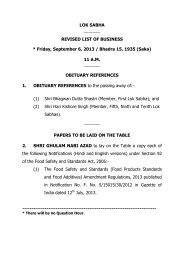
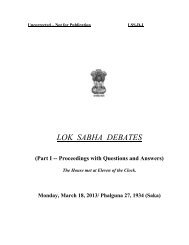

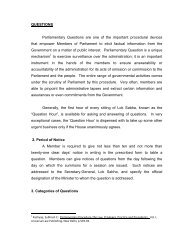
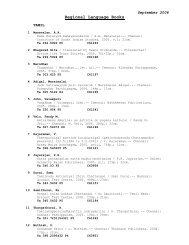

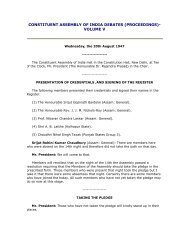
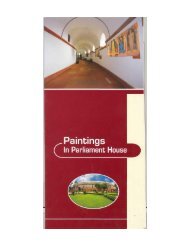
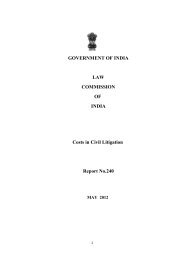
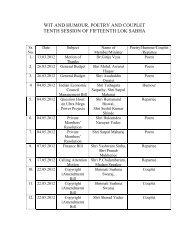
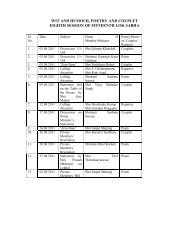

![gÉÉŌ A.]ÉŌ. xÉÉxÉÉ](https://img.yumpu.com/8015720/1/190x245/geeo-aeo-xeexee.jpg?quality=85)
